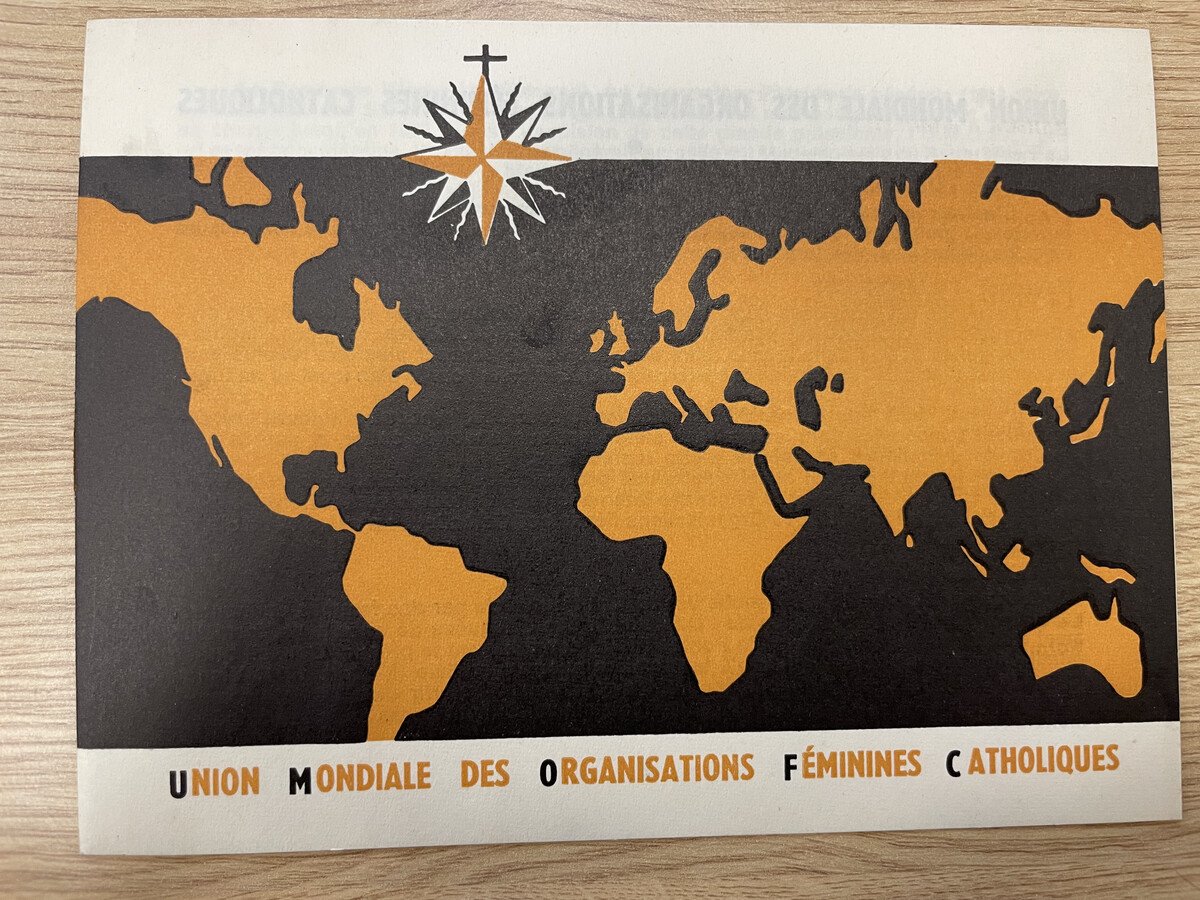#WomensWednesday – nº 3: 10th of September 2025. The World Union of Catholic Women’s Organisations (WUCWO). A Century of Catholic Women’s Global Leadership*
Founded in 1910 as the International Union of Catholic Women’s Leagues, WUCWO emerged in response to growing anticlericalism and secularization in Europe**. Its mission was to promote Catholic social action and values, and to defend religious freedom. The organization became truly international after World War II, adopting its current name in 1952. Today, WUCWO works to strengthen the presence, participation, and shared responsibility of Catholic women in both society and the Church, with a focus on evangelization, human development, poverty reduction, and the promotion of human rights.
Origins and Early Years (1910–1914)
The idea for the Union came from Madame de Vélard of the Patriotic League of French Women, in collaboration with the Marquise de Chastelle, president of the League of Christian Women in Brussels, and Baroness de Montenach, president of the International Catholic Association for the Protection of Young Women. Their initiative was supported by Pope Pius X, Cardinal Merry del Val, Mgr Amette (Archbishop of Paris), and Cardinal Mercier (Archbishop of Malines).
The first meeting was held in Brussels in 1910, bringing together representatives from France, the Netherlands, Germany, Spain, Switzerland, Italy, Belgium, Lorraine, Portugal, Uruguay, and Brazil. The Union’s goals were clear: to defend the faith, protect religious liberty, and organize social action based on Catholic principles. Its statutes were approved by Pius X in 1913, and by then, the Union had grown to include 27 organizations across 17 countries. From the beginning, the Union had a Cardinal Protector appointed by the Holy See (including Merry del Val, Ceretti, Dolci, and Pizzardo from 1939).
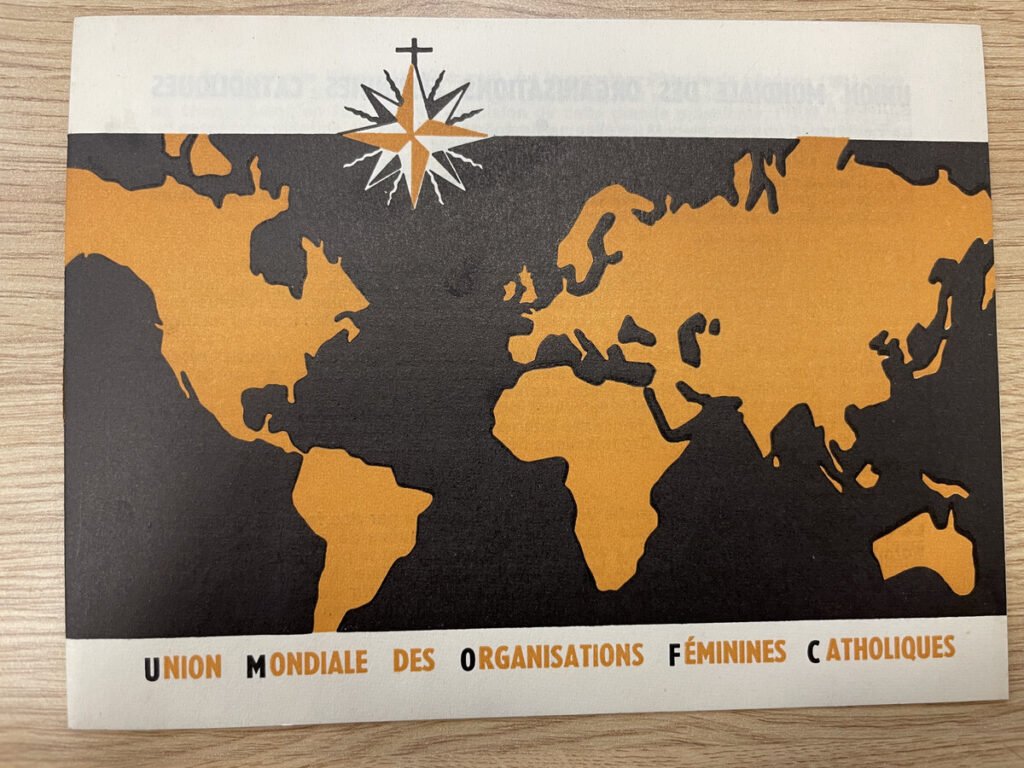
The Rise of International Engagement in the Interwar Years (1919-1939)
Activities paused during World War I (1914–1918), though the president maintained contact with the Vatican and national leagues. The Union resumed in 1921 with an executive meeting in Cracow, Poland. The Youth section was also created
Recognizing the importance of laywomen’s voices in global forums, the Union sought representation in international bodies. In 1928, it secured a seat on the League of Nations’ Committees on the Protection of Women and Children, and participated in the Geneva Disarmament Conference.
The Union’s mission expanded to include:
- Serving as a global hub for Catholic women’s organizations.
- Promoting Christian thought in public life.
- Coordinating laywomen’s contributions to international affairs.
- Representing Catholic women before international institutions.
- Giving global visibility to women’s apostolic work
Organizational Structure and Governance (in the 1950s)
Each affiliated organization had the right to send three delegates to the Union’s Council, which held legislative authority and elected the Executive Bureau. The Council met every two years, usually during Congresses or Study Days. The Executive Bureau held executive power and included:
- A President (elected by the Council with papal approval).
- An Ecclesiastical Assistant appointed by the Holy See.
- Several Vice-Presidents (often two, a Spanish speaking and an English one from the Americas).
- A Secretary, Treasurer, and other members (36 in 1956), elected or co-opted.
Certain positions were held exoficio, such as those by the presidents of the International Association for the Protection of Young Women and the World Federation of Catholic Young Women and Girls.
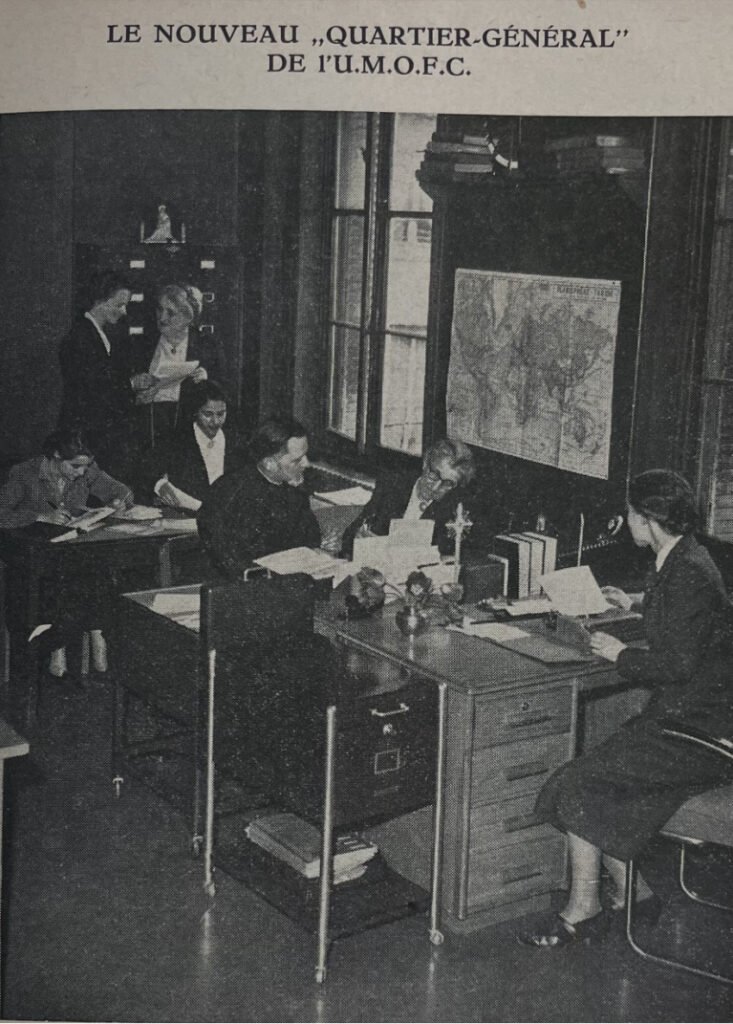
As the organisation grew, the Secretariat moved from The Hague to Utrecht, then to Paris in 1952, and it is now based in Rome. Communication with member organizations was maintained through circulars, letters, seminars, conferences and the Union’s publication: Feuilles d’information (1922), later renamed the Bulletin (1926).
Post–World War II Expansion and Global Reach
After World War II, in the context of the emergance of new international organisations and a new world order (Cold War and decolonisation), the Union renewed its commitment to recognizing women’s roles in both the Church and international life. In 1952, it became the World Union of Catholic Women’s Organisations (WUCWO), reflecting its expanded global scope. It began welcoming members from Africa, Asia-Pacific, and Oceania, embracing a diversity of races, cultures, and social backgrounds.
By the 1950s, WUCWO claimed to represent 36 million women across 105 organizations worldwide. This expansion was encouraged by the encyclical Fidei Donum (1957), which emphasized the Church’s missionary and social engagement, and encouraged laypeople to support the clergy worldwide, and notably in missionary lands.

As a consequence, WUCWO’s membership diversified beyond Catholic Action to include:
- Working-class and agrarian movements
- Family and Marian sodalities
- Domestic workers, merchants, intellectuals, students, teachers, mothers, and social center volunteers
Presence in International Institutions
WUCWO was active from the beginning in the United Nations and its specialized agencies. It obtained consultative status with:
- ECOSOC (1947)
- UNESCO (1948)
- UNICEF (1952)
- FAO (1953)
- Council of Europe (1955)
- Organization of American States (1954)
- International Labour Organization (1956)
Catholic women leaders contributed significantly to the consolidation of these bodies by preparing global studies, organizing regional workshops, participating in scholarships and issuing press releases to influence public opinion.
From Defense to Promotion: Evolving Priorities
Initially focused on defending Catholic values, such as the indissolubility of marriage, opposition to birth control, and the right of parents to educate their children, WUCWO gradually shifted towards a greater emphasis and promotion of women’s rights in education, health, and civic engagement. This transformation included a greater social sensibility. The numerous workshops they organized in all five continents also contributed to the professionalisation of women.
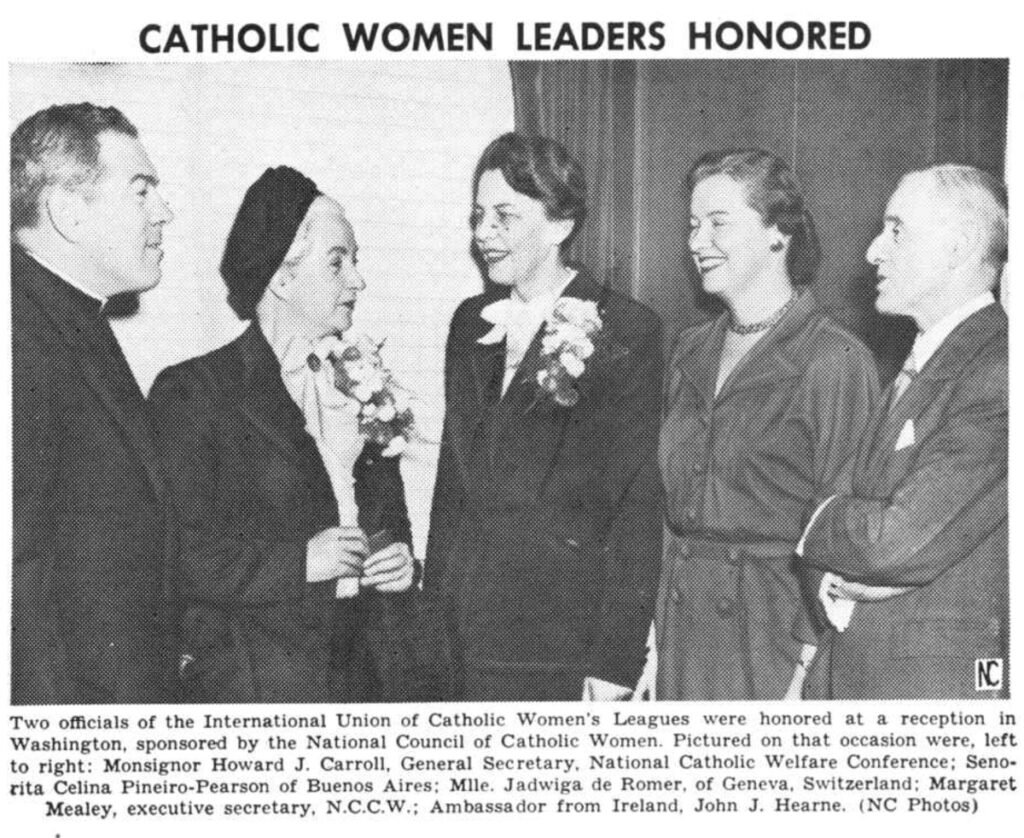
Notable interventions included
- Participation in the UN Commissions on the Declaration of Human Rigths and, from 1947, on the Status of Women.
- In 1958–1959, the Union advocated for access to education and the health of working mothers.
- A UNESCO-sponsored workshops, for example, the 1959’s meeting in Bogota was dedicated to women’s rights and civic responsibilities.
Beyond laywomen
The Union’s Youth Section was founded in 1926, and in 1947, became the World Federation of Catholic Young Women. WUCWO also participated in the International Catholic Migration Commission in Geneva through its ties with the International Association for the Protection of Young Women.
In 1927, Union helped found the Conference of Presidents of International Catholic Organizations, which later became the Conference of International Organizations in 1953, grouping 33 members. In 1947, the Union was entrusted with opening and managing the Catholic Center for Information on the UN in Geneva.
Finally, the Youth section of the UICWL was founded in 1926 and, in 1947, it became the The World Federation of Catholic Young Women and Girls.
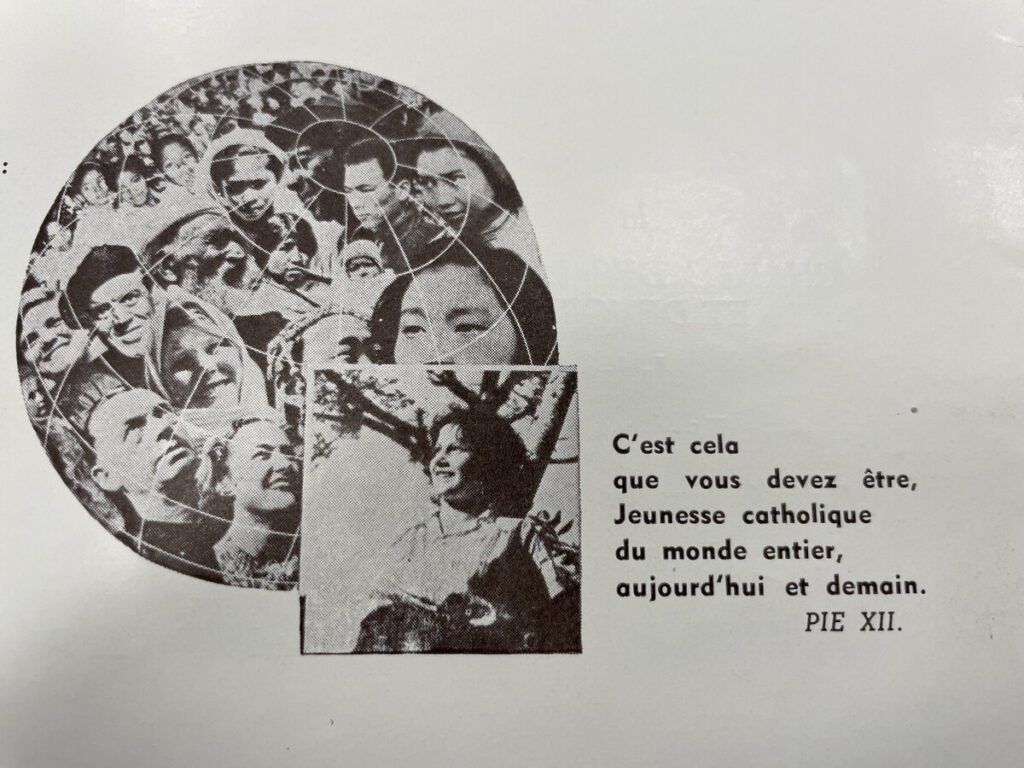
Legacy and Influence
Through its many activities, WUCWO has contributed to shaping a Catholic doctrine of women in the modern world, but also in key issues such as Human Rights. While change has been gradual, the Union has played a role in transforming Church governance from within, amplifying the voices of Catholic women across generations.
Chronological list of presidents:
1910: Viscountess de Velard (France) – Founder and leader
1911: Marchioness de Unza del Valle (Spain) – Elected to prepare the next Council
1912: Countess Zicky-Metternich (Austria) – Elected to prepare the next Council
1913: Margaret Fletcher (England) – Elected to prepare the next Council
1913–1922: Countess Vodzicka (Poland) – First International President
1922–1952: Mrs. Steenberghe-Engeringh (Netherlands), designated by the Pope.
1952–1961: Marie du Rostu (France), elected by the Council from now on.
1961–1974: María del Pilar Bellosillo (Spain)
1974–1983: Elizabeth Lovatt-Dolan (Ireland)
1983–1987: Eleanor E. Aitken (Canada)
1987–1996: Marie-Thérèse van Heteren-Hogenhuis (Netherlands)
1996–2006: Maria Eugenia Diaz de Pfennich (Mexico)
2006–2010: Karen M. Hurley (United States)
2010–2018: Maria Giovanna Ruggieri (Italy)
2018–2023: María Lía Zervino, Servidora (Argentina)
2023–present: Mónica Santamarina (Mexico)
*Source: L’Union Mondiale des organisations feminines catholiques a 50 ans, 1961, online version.
**Footnote: In the early 1900s, Europe saw major shifts toward secularism. France passed the Law of Separation of Church and State in 1905, ending official ties between government and religion. In Spain, the Tragic Week of Barcelona in 1909 led to violent attacks on churches and religious schools. Portugal became a republic in 1910, quickly banning religious orders and secularizing public life. These events reflected growing tensions between modern states and the Catholic Church.
For more reading:
- Della Sudda, Magali. “Réseaux catholiques féminins. Une perspective de genre sur une mobilisation transnationale.” Genre & Histoire, no. 14, 2014, pp. 37-60.
- Núñez Bargueño, Natalia. “Recovering the Legacy of the Thought of Catholic Lay Women (1945–62).” Journal of Modern and Contemporary Christianity, vol. 2, no. 1, April 2023, pp. 21–24. https://edizionicafoscari.unive.it/en/edizioni4/riviste/journal-of-modern-and-contemporary-christianity/2023/1/recovering-the-legacy-of-the-thought-of-catholic-l/
- Inmaculada Blasco Herranz, and Mónica Moreno Seco, ‘Españolas en el catolicismo internacional: la UMOFC, de la ‘personalidad de la mujer’ a la demanda de ‘derechos inalienables’, in: Natalia Núñez Bargueño and José Ramón Rodríguez Lago (eds.), Mas allá de los nacionalcatolicismos. redes transnacionales de los catolicismos hispánicos Sílex, 2021.

